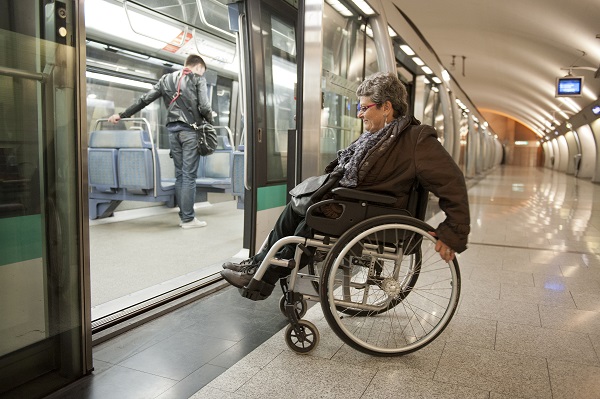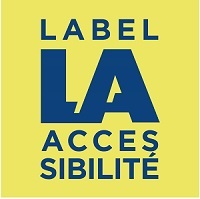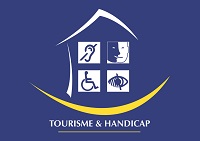
Photo above: Paris metro line 14, the only metro line autonomously accessible for wheelchair use. Martine and Hervé at the Olympiades station © OTCP, Daniel-Thierry.
This article follows an interview with architect Edouard Pastor, one of France’s leading experts on accessibility.
While many travelers scan the web for information as they prepare their trip to Paris, advance planning is especially important for those with a handicap or disability that may make it difficult or impossible to access certain museums and monuments.
The department of Durable and Adapted Tourism of the Paris Tourist Office communicates to tourism professionals and to the public about accessibility while also accompanying businesses in applying laws and being properly outfitted.
Hervé Guillon, the department’s coordinator for the past five years, is an urbanist who previously worked with Edouard Pastor at Handigo. Asked how Paris compares with other cities regarding accessibility, Guillon says, “We could do better, but we’re catching up with cities such as Barcelona and London. We’re not the best adapted as yet but we’re doing a good job at communicating what we have.”
The Paris Tourist Office provides extensive visitor information, including a list of accessible museums and monuments in and around the capital along with other useful information for those with a disability.
 A downloadable brochure in English entitled Accessible Paris provides information about adapted hotels and restaurants and about companies specialized in transporting people with disabilities, along with information about artistic, cultural, and entertainment venues. A paper version is also available in Paris tourist offices.
A downloadable brochure in English entitled Accessible Paris provides information about adapted hotels and restaurants and about companies specialized in transporting people with disabilities, along with information about artistic, cultural, and entertainment venues. A paper version is also available in Paris tourist offices.
Accessible.net lists accessible businesses and public buildings throughout France, and beyond.
Yanous.com is an online magazine in French with news and information useful for travelers and residents with a disability.
Jaccede.com/en/ is an internet guide and app that provides information about accessible businesses throughout France.
I Wheel Share is an app through which users share their experience about navigating Paris and other cities in view of physical and sensorial deficiencies.
Paris en Fauteuil Roulant (Paris in a wheelchair) is a Facebook page concerned with culture and lifestyle in the capital.
Labels of accessibility
 Edouard Pastor and Handigo have provided the know-how behind the creation of Label LA Accessibilité, used to indicate the accessibility and usage performances of non-residential buildings. Discerned by the CSTB, the France-based Scientific and Technical Centre for Construction, it has been available in France since the spring 2017 via its subsidy Certivea and will extend internationally via its subsidiary Cerway beginning in 2018.
Edouard Pastor and Handigo have provided the know-how behind the creation of Label LA Accessibilité, used to indicate the accessibility and usage performances of non-residential buildings. Discerned by the CSTB, the France-based Scientific and Technical Centre for Construction, it has been available in France since the spring 2017 via its subsidy Certivea and will extend internationally via its subsidiary Cerway beginning in 2018.
 Already well established, the label Tourisme & Handicap, France’s national Tourism & Disability mark, was created in 2001 for the purpose of “providing reliable information… about accessibility to tourism sites and facilities in relation to the four categories of disability … and to develop a range of adapted tourism options.” The awarding of the label, along with a recent national label Destination pour tous (destination for all), is managed by the association Tourisme & Handicaps.
Already well established, the label Tourisme & Handicap, France’s national Tourism & Disability mark, was created in 2001 for the purpose of “providing reliable information… about accessibility to tourism sites and facilities in relation to the four categories of disability … and to develop a range of adapted tourism options.” The awarding of the label, along with a recent national label Destination pour tous (destination for all), is managed by the association Tourisme & Handicaps.
Annette Masson, president since the association’s inception, said in a phone interview, “We used to knock at doors to get tourism professionals interested in our work, now they come to us. There’s been an evolution of mentality. In Europe, France is now in the average regarding accessibility but we’ve made enormous progress. It’s difficult to make an old country accessible.”
In becoming involved in issues concerning accessibility Masson was not in a situation of disability herself, nor was anyone in her immediate family, but she had come to know people who were and saw the problems that confronted them.
“It’s not up to only those with disabilities or those close to them to defend their rights,” she said. “It’s also a societal question. We have to stop thinking that only those in a situation of disability need to care about accessibility. We all do. The elevator may be essential for some but we’re all happy to see one as we get older or if we’re pushing a stroller. “
© Gary Lee Kraut
This article was first published in a slightly different version in the October 2017 issue of The Connexion.

